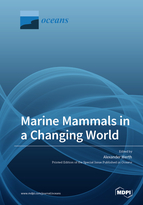Marine Mammals in a Changing World
A special issue of Oceans (ISSN 2673-1924).
Deadline for manuscript submissions: closed (31 January 2021) | Viewed by 32398
Special Issue Editor
Interests: marine mammals and other marine vertebrates; trophic ecology; physiology, morphology, and biomechanics; evolution; conservation
Special Issues, Collections and Topics in MDPI journals
Special Issue Information
Dear Colleagues,
Despite tremendous advances in our understanding of marine mammals over the past several decades, numerous unanswered questions remain. These include fundamental questions in every biological discipline as well as other areas of science, including basic and applied chemistry and physics. Current studies of marine mammals reflect major improvements in technology, as well as equally large changes in the ocean environment.
Contributions for this Special Issue are invited in all areas of marine mammal research, especially those that focus on one (or both) of two themes: changing technological advances and changes in ocean habitats affecting marine mammals (including but not limited to changes in climate/temperature; ocean acidification; noise, plastic, or chemical pollution; vessel traffic and ship strikes; pathogenic viruses and microbes; trophic changes; fisheries impacts; habitat destruction; and related topics).
Submissions can focus on any area of marine mammal research and health, including but not limited to ecology, conservation, population biology and management, behavior, habitat and distribution, genetics, evolution, physiology, anatomy, acoustics, effects of noise and pollution, and new technologies.
Dr. Alexander Werth
Guest Editor
Manuscript Submission Information
Manuscripts should be submitted online at www.mdpi.com by registering and logging in to this website. Once you are registered, click here to go to the submission form. Manuscripts can be submitted until the deadline. All papers will be peer-reviewed. Accepted papers will be published continuously in the journal (as soon as accepted) and will be listed together on the special issue website. Research articles, review articles as well as short communications are invited. For planned papers, a title and short abstract (about 100 words) can be sent to the Editorial Office for announcement on this website.
Submitted manuscripts should not have been published previously, nor be under consideration for publication elsewhere (except conference proceedings papers). All manuscripts are thoroughly refereed through a single-blind peer-review process. A guide for authors and other relevant information for submission of manuscripts is available on the Instructions for Authors page. Oceans is an international peer-reviewed open access quarterly journal published by MDPI.
Please visit the Instructions for Authors page before submitting a manuscript. The Article Processing Charge (APC) for publication in this open access journal is 1000 CHF (Swiss Francs). In 2020, the APC will be fully subsidized by MDPI. Submitted papers should be well formatted and use good English. Authors may use MDPI's English editing service prior to publication or during author revisions.






